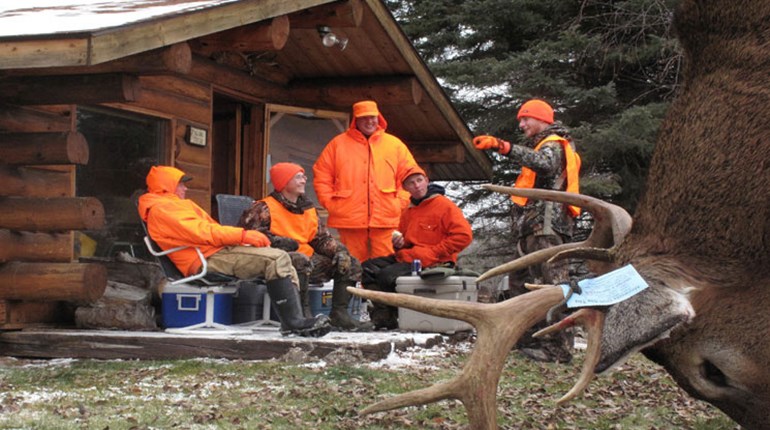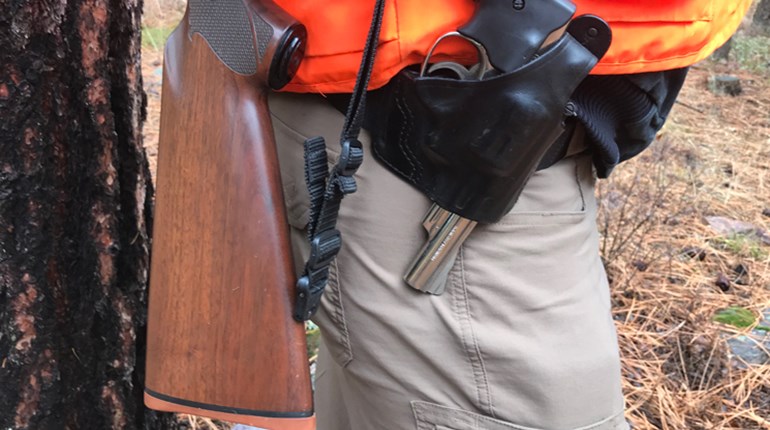If natural selection is the answer to why rabbits are the color of rotting leaves then why didn’t it do something about their tastiness? Obviously foxes and hawks have figured out Mother Nature’s trick, but I bet they’ve never had good hasenpfeffer (rabbit stew). I can’t go through winter without it. So this time of year I think about where I can find cottontails. I used to hunt with a friend who trained beagles, but he has given them up. His second wife doesn’t care for their incessant barking—though he happily credits the loss of the first wife to all that beagle clamor. So these days I mostly have to earn my hasenpfeffer without the help of beagles. Doing so, however, isn’t as daunting as some surmise. Like hunting whitetails, it just takes scouting and clever tactics.
Finding Rabbit Patches
Cottontails typically live in areas of less than 10 acres. They can breed five times or more per year with each litter having from three to eight offspring. Young rabbits can hop out of the nest at two weeks old. Though they can live longer than six years, their average life expectancy in the wild is less than one. What such facts tell us is it’s best to start by locating good rabbit patches, as rabbits, well, breed like rabbits in habitat that suits them.
Abandoned farms with rusting machinery, rotting barns and overgrown pastures are ideal. When I lived in Wyoming I found that all you had to do was look out across the sage for a lone tree and a few abandoned homesteads. There would always be rabbits in those places. Farther east you need brush, briars and other habitat that stays thick even in bleak winters. Another great location is an overgrown apple orchard. CRP fields are often prime locations as well. Swamp edges and other riparian habitat can also be excellent. Such places have cover for rabbits to avoid hawks and often have nearby food sources such as crop fields and edges.
The best way to locate prime rabbit patches is to go for a drive. Take note of the cover, terrain and food sources. Grapes, berries, red osier dogwoods, fruit trees, young saplings and much more are rabbit foods. Rabbits eat almost anything that is growing, but once the green stuff is gone, they eat the bark off twigs and small trees. They sometimes girdle fruit trees, which is why orchard owners despise them. Most of the best areas are private, but some states lease timber company lands or brush hog areas to help upland birds. Also, the National Wildlife Refuge System often allows small-game hunting. These places often have good rabbit cover (find places here).
10 Tactics Without Dogs
1. Like deer, rabbits are crepuscular—they are most active around dawn and dusk. I like to take a stand early and late and watch a place where several rabbit-runs come together. In places where it snows these are very easy to find. In other places, fencerows, ditches and other cover are often rabbit byways.
2. After a cold snap cottontails will often sit out soaking up sunlight. In open areas you can spot them by carefully glassing. They’re easier to jump at such times.
3. Never pass up a chance to hunt during a snowstorm—especially in late afternoon. Rabbits move when the snow falls. Get out and move slowly. Bend down and look into cover at their level. Be ready to shoot fast.
4. On cold and windy days they’ll sit in thick tangles of vines, briars and other cover. Hunt with a partner. Have one person stand where several ditches or fencerows come together. The other hunter will kick though the brush as he moves down the fencerow or other cover.
5. Brush piles are good on just about any day, but are difficult to hunt alone. One person should put down his gun and disturb the pile. The other person should stand nearby and only shoot the rabbit after it passes him.
6. Overgrown orchards are easy to hunt without a dog. Move very slowly while stepping on or into cover that could conceal a rabbit. When a rabbit runs, it typically goes right down between the trees.
7. Rabbits normally follow a fencerow before running for cover. Have another hunter stand at the end. The best locations are at intersections of two fencerows or where a thicket bottlenecks into some other cover.
8. If you’re hunting alone, stop, take a few short steps and stop again. Don’t move too fast. In prime habitat only cover 100 yards in a half hour.
9. Like upland birds, cottontail numbers often rise and fall cyclically. The population builds up to a very high level before disease, habitat changes or predation send it crashing. Peak populations usually occur at intervals of about 10 years. Within this cycle there will be local areas with highs or lows opposite the overall trend. This is why you need to scout for more than just good habitat. You also have to find rabbits.
10. When asking for permission to hunt bring your son or daughter (niece or nephew) along and don’t wear your hunting clothes. Often the suburbs have the best rabbit cover. These folks aren’t always sure about hunting. And, after all, this is an ideal hunt for youngsters.




































